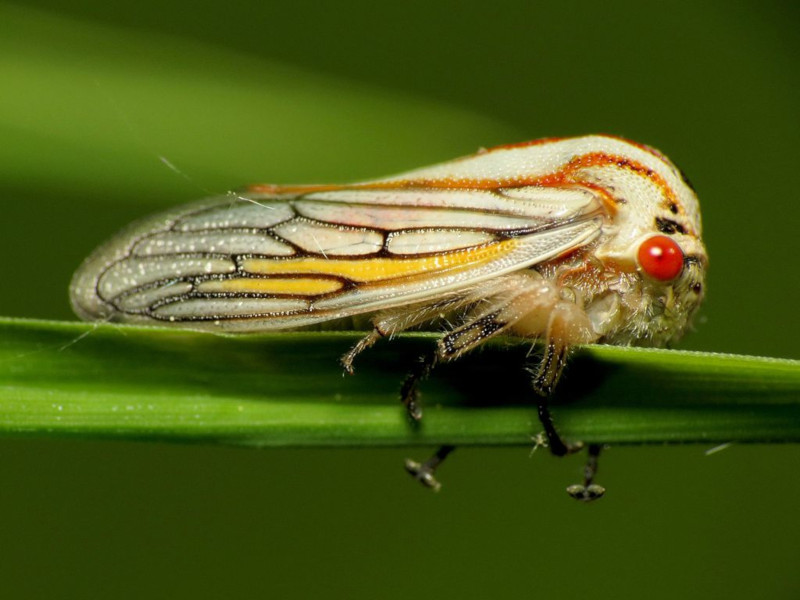Oak Treehopper Facts
- The single term of Oak Treehopper actually represents the accepted common name of either of two separate, specific varieties of Treehopper. The complex scientific names of these two species are Platycotis vittata and Platycotis quadrivittata.
- Regardless of which particular term one uses to refer to them, these remain fascinating invertebrates. Furthermore, despite the specific name, both of these species appear to inhabit both evergreen and deciduous oak trees with equal enthusiasm.
- Furthermore, each of the two varieties of Oak Treehopper also shares a remarkable, and sometimes destructive, behavior. That’s a tendency to congregate in large numbers. Understandably, this patterns also holds especially true during mating season.
- Also, at times, their numbers on a given tree can represent a potential danger for the tree itself. However, regardless of the numbers involved, actual physical damage caused by the Oak Treehopper to the trees remains extremely rare.
- Any physical damage inflicted upon a tree by the presence of one or both of the species generally remains limited to minor scarring on the smaller limbs. Quite fortunately, for the moment, neither of these creatures appears on the IUCN Red List.
- Nonetheless, it must be considered that the populations of both remain at some risk. This further remains the case due to several different threats. While the factors vary, this primarily holds true due to the ongoing effects of climate change.
Related Articles
Oak Treehopper Physical Description
It bears mentioning that, while not a large insect, both forms of the Oak Treehopper nonetheless rank as relatively large compared to related creatures. Furthermore, on average, these arthropods possess bodies having a proportionately heavier body.
These also most commonly display a more triangular body than similar species. In addition, both forms attain approximately the same general physical shape. This partially consists of the fact that an average length measures roughly 0.35 in (9 mm).
That, however, does not include any horn that may be present. Quite remarkably, this occurs due to the fact that some individuals develop one and some do not. Also, the intermittent horn itself, when present, adds an extra 0.16 in (4 mm) to the overall length.
Physical appearances vary among individuals of the Oak Treehopper. The great majority of specimens observed display a variety of stripes. But, both the colors of these stripes, as well as their placement and width also vary greatly between individual specimens.
- Kingdom: Animalia
- Phylum: Arthropoda
- Class: Insecta
- Order: Hemiptera
- Family: Membracidae
- Genus: Platycotis
Oak Treehopper Distribution, Habitat, and Ecology
Surprisingly, both forms of the visually lovely Oak Treehopper evolved as endemic to a relatively broad section of the globe. That holds true due to the fact that the majority of individuals of both species occur naturally in a specific section of the Northern Hemisphere.
In point of fact, both species evolved as endemic in an area that extends across much of the continent of North America. More precisely, though, most of them appear in quite specific portions of both the United States and the country of Mexico.
Nevertheless, scattered, populations also appear as far north as Vancouver Island, Canada, and as far south as Brazil, in South America. But, wherever the fascinating animal appears within this range, it may be found anywhere large groupings of oak trees are present.
Originally, this habitat consisted of the large temperate forests that covered a great portion of the region. Now, however, this zone of habitation has modified somewhat, given human expansion. It now often even includes forests and parks, and even private yards.
Within the United States, the habitat of the Oak Treehopper continues to be primarily restricted to a narrow, U-shaped swathe. This primarily extends through the coastal regions of Oregon, California, Texas, Mississippi, Florida, Georgia, the Carolinas, and New Jersey.
Species Sharing Its Range
Check out our other articles on 4 Stupendous Stick Insects, Spotted Handfish, Fly Geyser, Culpeo, Christmas Cheer, Tiger Rattlesnake, Brazilian Wandering Spider, Mountain Chicken

